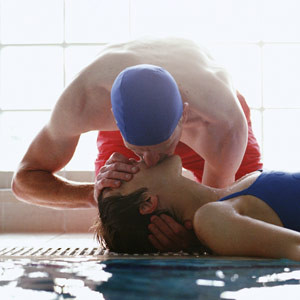It is important to note that calf cramps can cause a lot of pain and forces the individual to stop swimming without any warning. Since it occurs abruptly and can be debilitating, cramps can be dangerous especially if the individual is swimming far from the shore or in deep water.
http://youtu.be/3AvIiuPmkRc
Cramps are known to cause drowning among those who are not skilled enough or unprepared. If the individual is experiencing calf cramps while swimming, the body is providing an indication that he/she should comply with the needs of the body more effectively in order to reduce the cramping. It is important that you are prepared to help out an individual suffering from calf cramps by enrolling in a first aid course today.

Proper hydration and electrolytes
Poor nutrition and inadequate hydration are the common causes of calf cramps. Even though it seems unnecessary to hydrate while in water, the reality is that the individual is still perspiring while swimming, thus fluids are lost.
It is important to ensure that the body is properly hydrated before, during and after swimming to reduce the occurrence of calf cramps. Additionally, calf cramps can indicate an electrolyte imbalance due to the low levels of potassium, magnesium and calcium. You can provide the individual with an electrolyte replacement drink while working out or add foods that are rich in these nutrients such as green leafy vegetables for magnesium, bananas for potassium and dairy products for calcium.
Using fins
The individual can also experience increased occurrence of calf cramps when fins are used and this is because the individual tenses up the muscles more when the fin is used. The individual should work on swimming without the fins and always make sure to relax the ankles and move in a natural manner. When the individual attempts to use fins, he/she must start using short fins first and then swim on the back, making sure not to tense the muscles in the shin or calf. Larger fins can be used if the individual is capable of swimming face down using the small fins without cramping.
Proper positioning of the ankle
The individual can experience calf cramps when swimming at high speeds. This occurs since the individual plantar flexes the ankles in which the toes are pointed out like a ballerina in order to get the most water resistance and power. Nevertheless, this position is considered unnatural for the ankles and causes tightness, cramping and tension in the calf. The individual should slow down and pay close attention to the movement of the ankles so that they are allowed to relax and move normally.
Deconditioning
Always bear in mind that deconditioning is another common cause of calf cramps especially when swimming. Muscles that are weak with poor endurance could not adequately respond to the abrupt increase in physical activity. This results to the formation of micro tears in the muscle and lack of oxygen which can lead to calf cramps. Swimming is considered as a reduced-joint-impact activity, many individuals will start swimming when they have participated in minimal physical activity and are usually out of shape.
